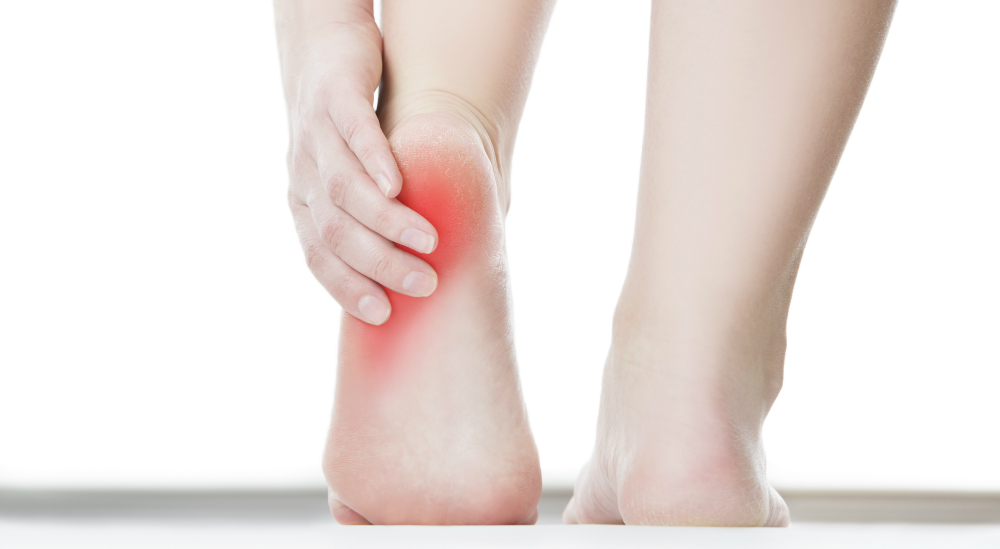Heel Health for ALL Milwaukee Seasons
In Milwaukee, we have a vibrant, active community of residents who love staying active by playing sports like basketball, softball, volleyball, and flag football. For those who are interested in such pursuits, Milwaukee Recreation (a division of the Milwaukee Public School System) offers a variety of adult rec leagues all year round.
In addition to organized sporting leagues, the Milwaukee County Parks system contains various athletic fields and courts used often throughout our warmer months by community members.
Of course, no matter if we are talking about a summer softball league game at Humboldt Park or pond hockey in the winter at Burnham Playfield there is one thing all sports have in common – the opportunity for injury.
One of the more common foot and ankle sports injuries is heel pain. This isn’t something that should make you want to avoid physical activity, however. Most cases are treated at Wisconsin Foot Center without surgery and, even better, can be prevented.
(We don’t want you to allow a fear of injury keep you from all the benefits you can achieve from leading an active lifestyle!)
Now, sometimes problems that are rather commonplace—like heel pain—lead to quick dismissals from people who think they aren’t a big deal. Having that kind of a mindset can become a big problem!
When you don’t take measures to address a health issue, it will generally worsen over time. This is something that can easily happen with heel pain. A minor, nagging injury can become the source of tremendous pain when left untreated. When this happens it’s quite unfortunate because treatment could have resolved the issue.
There are a couple of reasons as to why heel pain is such a widespread problem – heels endure tremendous amounts of physical forces and there are several conditions that can cause it.
We all take this for granted, but our feet face a lot of pressure. In addition to supporting our body weight when standing—which is something that can be taxing in and of itself—walking and running increase the amount of physical forces placed on the lower limbs. As a matter of fact, heels can receive forces up to four times your bodyweight when you jog or run!

When it comes to the various causes of heel pain, some of the more common ones include:
- Plantar fasciitis. The leading cause of heel pain for adults, this condition develops when the plantar fascia—a fibrous band of tissue running along the bottom of the foot—sustains tears on account of excessive stress. It is common to have sharp, intense pain in the bottom of the heel, particularly following sleep or extended periods of rest or inactivity.
- Achilles tendinitis. When intense physical activity is suddenly performed, or the Achilles tendon becomes inflamed due to overuse, you can develop pain in the back of the heel. You will find this to be strongest during and following physical activity.
- Sever’s disease. Plantar fasciitis is the most common source of heel pain for adults, but this is the leading cause for adolescents. When the lower limbs are developing, the heel bone can sometimes reach physical maturity before the Achilles tendon. This causes pulling in the back of the heel, and the pain is often increased with physical activity.
There are other causes of heel pain—like heel bone fractures, bursitis, and heel spurs—but the common thread binding all of these conditions is the fact you should seek professional diagnosis and treatment at our Milwaukee podiatrist office. Doing so will not only relieve existing symptoms, but also help prevent long-term issues.
When our weather becomes more agreeable, you may find yourself inclined to either start or recommit to running. Be careful, though, of overtraining! Doing so can lead to common overuse injuries like plantar fasciitis and Achilles tendinitis.
There are stretching exercises that are not only beneficial in alleviating the pain you encounter from these conditions, but also prevent them from happening in the first place. Some of the better ones include:
- Achilles tendon stretch. Stand approximately a foot and a half in front of a wall with your hands on it. Place your left foot behind the right one so the toes touch the heel. Keeping your back leg straight, bend your front knee until you feel the stretch in your lower left leg. Hold for 10 seconds and then switch legs. Repeat two more times.
- Plantar fascia stretch. Sit barefoot in a chair and place your foot over your knee. Using the hand on the same side as your foot, gently pull back on your toes until you feel a good stretch along the bottom of your foot. Hold for 10 seconds and then switch feet. Repeat two more times.
- Eccentric heel drop. Standing on the edge of a step (with only the toes and ball of foot making contact with the step) and facing the stairs, slowly lower both heels down, hold for 10 seconds, and then raise back up to the starting position. Repeat 10-15 times.

Stretching exercises are a great way to start—and may turn out to be all the care you need—but it’s certainly possible you will require additional treatment measures. For an accurate diagnosis and professional treatment plan, request an appointment with our Hales Corner office.
Other ways of lowering your risk for heel pain from running or other activities include:
- Choose the right footwear. There are two facets to this – wear running shoes and make sure they fit. In theory, you can run in any type of shoe, but running shoes are intended for this activity. Naturally, an ill-fitting pair of running shoes will not provide optimal protection and support, so choose ones that fit correctly.
- Ease into it. Trying to do too much too soon is a surefire recipe for injury. If you haven’t run for a while (or ever), you might want to start with a walk/run mix. Four minutes walking, followed by 1 minute of easy running or jogging (and then repeating the sequence) is a smart way to begin your new workout program.
- Warm up and stretch first. You need to properly prepare your body before engaging in physical activity, and this means taking time for a warmup and some dynamic stretching.
Even when you follow these running injury prevention tips, there’s still a chance you might sustain an injury that causes heel pain. If you do, come see us!
There are several different nonsurgical components we could potentially incorporate into your heel pain treatment plan, including:
- Rest. Taking time away from high-impact activities or, even better, replacing them with low-impact ones (cycling, swimming) will better allow your body to repair damaged tissues.
- Ice. An appropriate icing regimen can relieve inflammation in the plantar fascia or Achilles tendon and reduce pain.
- Stretches. As noted, keeping the soft tissues in your lower limbs can help relieve painful symptoms, and also prevent the condition from becoming a recurrent issue.
- Medication. We may recommend or prescribe certain pain relievers (including ibuprofen and naproxen), or use corticosteroid injections to provide relief. The specific medication will depend on various factors.
- Orthotic devices. For some patients, we either recommend certain heel cups (or specific shoe inserts) or prescribe custom orthotics. Devices like these can help by more equitably distributing force loads – so your connective tissues do not have to shoulder too much of the load.
Heel pain is something that should never be ignored, especially because it’s easy to receive the care you need here at Wisconsin Foot Center. We treat a wide array of foot and ankle conditions for patients from across the greater Milwaukee communities, so contact us for an appointment today.
Call us at (414) 425-8400 or connect with us online right now!
Request an Appointment
© Wisconsin Foot Center. All Rights Reserved.
Website & Marketing By Podiatry Growth

